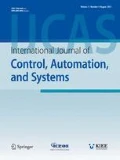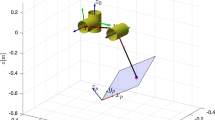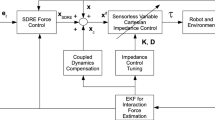Abstract
Generally, stiffness and impedance control schemes require knowledge of the location of any object with which a robot interacts within its workspace; therefore, the integration of a computer vision system within the control loop allows us to know the location of the robot end effector and the object (target) simultaneously. In this paper, a generalized and saturating vision-based stiffness controller with adaptive gravity compensation is presented. The proposed control algorithm is designed to regulate robot-environment interaction in task-space, where the contact force is modeled as a vector of generalized bounded spring-like forces. In order to control nonredundant robots, the proposed controller has a nonlinear proportional-derivative structure with static model-based compensation of gravitational forces, as it includes a regressor-based adaptive term. To support the proposal, the Lyapunov stability analysis of the closed-loop equilibrium vector is presented. Finally, the suitable performance of the proposed scheme was verified by numerical simulations and experimental tests.
Similar content being viewed by others
References
R. Garrido and M. Trujano, “Stability analysis of a visual pid controller applied to a planar parallel robot,” International Journal of Control, Automation and Systems, vol. 17, no. 6, pp. 1589–1598, 2019.
S. Jeong and S. Jung, “Cartesian space control of a quadrotor system based on low cost localization under a vision system,” International Journal of Control, Automation and Systems, vol. 14, no. 2, pp. 549–559, 2016.
F. Chaumette and S. Hutchinson, “Visual servo control: I. basic approaches,” IEEE Robotics & Automation Magazine, vol. 13, no. 4, pp. 82–90, 2006.
F. Chaumette and S. Hutchinson, “Visual servo control: Ii. advanced approaches [tutorial],” IEEE Robotics & Automation Magazine, vol. 14, no. 1, pp. 109–118, 2007.
O. Bourquardez, R. Mahony, N. Guenard, F. Chaumette, T. Hamel, and L. Eck, “Image-based visual servo control of the translation kinematics of a quadrotor aerial vehicle,” IEEE Trans. on Robotics, vol. 25, no. 3, pp. 743–749, 2009.
N. Tian, A. Tanwani, J. Chen, M. Ma, R. Zhang, B. Huang, K. Goldberg, and S. Sojoudi, “A fog robotic system for dynamic visual servoing,” Proc. of IEEE Int. Conf. on Robotics and Automation, pp. 1982–1988, 2019.
H. Wu, L. Lou, C. Chen, S. Hirche, and K. Kuhnlenz, “Cloud-based networked visual servo control,” IEEE Trans. on Industrial Electronics, vol. 60, no. 2, pp. 554–566, 2012.
R. Kelly, “Robust asymptotically stable visual servoing of planar robots,” IEEE Trans. on Robotics and Automation, vol. 12, no. 5, pp. 759–766, 1996.
P. Long, W. Khalil, and P. Martinet, “Robotic cutting of soft materials using force control & image moments,” Proc. of 13th IEEE Int. Conf. on Control Automation Robotics & Vision, pp. 474–479, 2014.
C. Chávez-Olivares, F. Reyes, and E. González-Galván, “On explicit force regulation with active velocity damping for robot manipulators,” Automatika, vol. 56, no. 4, pp. 478–490, 2015.
S. Chiaverini and L. Sciavicco, “The parallel approach to force/position control of robotic manipulators,” IEEE Trans. on Robotics and Automation, vol. 9, no. 4, pp. 361–373, 1993.
H. Wang and Y. Xie, “Adaptive Jacobian position/force tracking control of free-flying manipulators,” Robotics and Autonomous Systems, vol. 57, no. 2, pp. 173–181, 2009.
C. Chavez-Olivares, F. Reyes, and E. Gonzalez-Galvan, “On stiffness regulators with dissipative injection for robot manipulators,” International Journal of Advanced Robotic Systems, vol. 12, no. 6, p. 65, 2015.
N. Hogan, “Stable execution of contact tasks using impedance control,” Proc. of IEEE Int. Conf. on Robotics and Automation, vol. 4, pp. 1047–1054, 1987.
X. Li, Y. Liu, and H. Yu, “Iterative learning impedance control for rehabilitation robots driven by series elastic actuators,” Automatica, vol. 90, pp. 1–7, 2018.
B. Nelson and P. Khosla, “Force and vision resolvability for assimilating disparate sensory feedback,” IEEE Trans. on Robotics and Automation, vol. 12, no. 5, pp. 714–731, 1996.
M. Bdiwi, A. Winkler, J. Suchy, and G. Zschocke, “Traded and shared vision-force robot control for improved impact control,” Proc. of IEEE 8th Int. Multi-Conference on Systems, Signals & Devices, pp. 1–6, 2011.
M. Prats, P. Martinet, A. Del-Pobil, and S. Lee, “Robotic execution of everyday tasks by means of external vision/force control,” Intelligent Service Robotics, vol. 1, no. 3, pp. 253–266, 2008.
V. Lippiello, B. Siciliano, and L. Villani, “A position-based visual impedance control for robot manipulators,” Proc. of IEEE Int. Conf. on Robotics and Automation, pp. 2068–2073, 2007.
V. Lippiello, B. Siciliano, and L. Villani, “Position-based visual servoing in industrial multirobot cells using a hybrid camera configuration,” IEEE Trans. on Robotics, vol. 23, no. 1, pp. 73–86, 2007.
E. Aguinaga, A. Zavala-Río, V. Santibáñez, and F. Reyes, “Global trajectory tracking through static feedback for robot manipulators with bounded inputs,” IEEE Trans. on Control Systems Technology, vol. 17, no. 4, pp. 934–944, 2009.
D. López-Araujo, A. Loría, and A. Zavala-Río, “Adaptive tracking control of Euler-Lagrange systems with bounded controls,” International Journal of Adaptive Control and Signal Processing, vol. 31, no. 3, pp. 299–313, 2017.
D. López-Araujo, A. Zavala-Río, V. Santibáñez, and F. Reyes, “A generalized scheme for the global adaptive regulation of robot manipulators with bounded inputs,” Robotica, vol. 31, no. 7, pp. 1103–1117, 2013.
M. Mendoza, A. Zavala-Río, V. Santibáñez, and F. Reyes, “A generalised pid-type control scheme with simple tuning for the global regulation of robot manipulators with constrained inputs,” International Journal of Control, vol. 88, no. 10, pp. 1995–2012, 2015.
G. Zamora-Gómez, A. Zavala-Río, D. López-Araujo, E. Nuño, and E. Cruz-Zavala, “An output-feedback global continuous control scheme with desired gravity compensation for the finite-time and exponential regulation of bounded-input robotic systems,” Proc. of 12th IFAC Symposium on Robot Control, pp. 108–114, 2018.
R. Kikuuwe, “A sliding-mode-like position controller for admittance control with bounded actuator force,” IEEE Trans. on Mechatronics, vol. 19, no. 5, pp. 1489–1500, 2013.
W. He, Y. Dong, and C. Sun, “Adaptive neural impedance control of a robotic manipulator with input saturation,” IEEE Trans. on Systems, Man, and Cybernetics: Systems, vol. 46, no. 3, pp. 334–344, 2015.
E. Arefinia, H. Talebi, and A. Doustmohammadi, “A robust adaptive model reference impedance control of a robotic manipulator with actuator saturation,” IEEE Trans. on Systems, Man, and Cybernetics: Systems, 2017.
G. Peng, C. Yang, W. He, and C. Chen, “Force sensorless admittance control with neural learning for robots with actuator saturation,” IEEE Trans. on Industrial Electronics, vol. 67, no. 4, pp. 3138–3148, 2020.
D. López-Araujo, A. Zavala-Río, V. Santibáñez, and F. Reyes, “A generalized global adaptive tracking control scheme for robot manipulators with bounded inputs,” International Journal of Adaptive Control and Signal Processing, vol. 29, no. 2, pp. 180–200, 2015.
A. Teel, “Global stabilization and restricted tracking for multiple integrators with bounded controls,” Systems & Control Letters, vol. 18, no. 3, pp. 165–171, 1992.
H. Khalil, Nonlinear Systems, Prentice Hall, 2002.
M. Ge, Z. Liu, G. Wen, X. Yu, and T. Huang, “Hierarchical controller-estimator for coordination of networked Euler-Lagrange systems,” IEEE Trans. on Cybernetics, vol. 50, no. 6, pp. 2450–2461, 2020.
T. Ding, M. Ge, Z. Liu, Y. Wang, and H. Karimi, “Discrete-communication-based bipartite tracking of networked robotic systems via hierarchical hybrid control,” IEEE Trans. on Circuits and Systems I, vol. 67, no. 4, pp. 1402–1412, 2020.
R. Kelly, V. Santibáñez, and A. Loría, “Control of robot manipulators in joint space,” 2005.
M. Rodríguez-Liñán, M. Mendoza, I. Bonilla, and C. Chávez, “Saturating stiffness control of robot manipulators with bounded inputs,” International Journal of Applied Mathematics and Computer Science, vol. 27, no. 1, pp. 79–90, 2017.
C. Canudas, B. Siciliano, and G. Bastin, Theory of Robot Control, Springer Science & Business Media, 2012.
P. Corke, Robotics, Vision and Control: Fundamental Algorithms in MATLAB®, Springer, 2017.
S. Hutchinson, G. Hager, and P. Corke, “A tutorial on visual servo control,” IEEE Trans. on Robotics and Automation, vol. 12, no. 5, pp. 651–670, 1996.
F. Reyes and R. Kelly, “Experimental evaluation of identification schemes on a direct drive robot,” Robotica, vol. 15, no. 5, pp. 563–571, 1997.
Author information
Authors and Affiliations
Corresponding author
Additional information
Publisher’s Note Springer Nature remains neutral with regard to jurisdictional claims in published maps and institutional affiliations.
Recommended by Associate Editor Yangmin Li under the direction of Myo Taeg Lim. This was work was supported by the Autonomous University of San Luis Potosi (C19-FAI-05-58.58) and the National Council for Science and Technology of Mexico (Grants 707604 and 707689).
Carlos Vidrios-Serrano received his B.E. and M.Sc. degrees in electronic engineering from the Autonomous University of Nayarit (AUN) and the Autonomous University of San Luis Potosi (AUSLP), Mexico, in 2004 and 2014, respectively. He is currently a Ph.D. candidate at the Faculty of Science, AUSLP and a full professor at the AUN, Mexico. His research interests include visual servoing, robot control and rehabilitation robotics.
Marco Mendoza received his B.E. degree in communications and electronics from the University of Colima, Mexico, in 2003, an M.Sc. degree in electronics from the Autonomous University of Puebla, Mexico, in 2006, and a Ph.D. degree in electrical engineering from the Autonomous University of San Luis Potosi (AUSLP), Mexico, in 2011. He is currently a full professor of biomedical engineering at the Faculty of Science, AUSLP, Mexico. His research interests include robot control and biorobotics.
Isela Bonilla received her B.E. degree in communications and electronics from the University of Colima, Mexico, in 2003, an M.Sc. degree in electronics from the Autonomous University of Puebla, Mexico, in 2006, and a Ph.D. degree in electrical engineering from the Autonomous University of San Luis Potosi (AUSLP), in 2011. She is currently a full professor of electronics at the Faculty of Science, AUSLP, Mexico. Her research interests include robot control and rehabilitation robotics.
Berenice Maldonado-Fregoso received her B.E. degree in control and computation from the Autonomous University of Nayarit, Mexico, in 2009, and an M.Sc. degree in electronic engineering from the Autonomous University of San Luis Potosi (AUSLP), Mexico, in 2014. She is currently a Ph.D. candidate at the Faculty of Science, AUSLP, Mexico. Her research interests include robot control and rehabilitation robotics.
Rights and permissions
About this article
Cite this article
Vidrios-Serrano, C., Mendoza, M., Bonilla, I. et al. A Generalized Vision-based Stiffness Controller for Robot Manipulators with Bounded Inputs. Int. J. Control Autom. Syst. 19, 548–561 (2021). https://doi.org/10.1007/s12555-019-1056-7
Received:
Revised:
Accepted:
Published:
Issue Date:
DOI: https://doi.org/10.1007/s12555-019-1056-7




